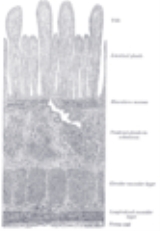
Muscularis mucosae
Encyclopedia
The lamina muscularis mucosae (or muscularis mucosae) is the thin layer of smooth muscle
found in most parts of the gastrointestinal tract
, located outside the lamina propria mucosae
and separating it from the submucosa
.
In the gastrointestinal tract, the term mucosa or "mucous membrane" refers to the combination of epithelium, lamina propria, and (where it occurs) muscularis mucosae. The etymology suggests this since the Latin names translate to "the mucosa's own special layer" (lamina propria mucosae) and "muscular layer of the mucosa" (lamina muscularis mucosae).
The muscularis mucosae is composed of several thin layers of smooth muscle fibers oriented in different ways which keep the mucosal surface and underlying glands in a constant state of gentle agitation to expel contents of glandular crypts
and enhance contact between epithelium and the contents of the lumen
.
Smooth muscle
Smooth muscle is an involuntary non-striated muscle. It is divided into two sub-groups; the single-unit and multiunit smooth muscle. Within single-unit smooth muscle tissues, the autonomic nervous system innervates a single cell within a sheet or bundle and the action potential is propagated by...
found in most parts of the gastrointestinal tract
Gastrointestinal tract
The human gastrointestinal tract refers to the stomach and intestine, and sometimes to all the structures from the mouth to the anus. ....
, located outside the lamina propria mucosae
Lamina propria
The lamina propria is a constituent of the moist linings known as mucous membranes or mucosa, which line various tubes in the body ....
and separating it from the submucosa
Submucosa
In the gastrointestinal tract, the submucosa is the layer of dense irregular connective tissue or loose connective tissue that supports the mucosa, as well as joins the mucosa to the bulk of underlying smooth muscle .-Contents:Blood vessels, lymphatic vessels, and nerves will run through...
.
In the gastrointestinal tract, the term mucosa or "mucous membrane" refers to the combination of epithelium, lamina propria, and (where it occurs) muscularis mucosae. The etymology suggests this since the Latin names translate to "the mucosa's own special layer" (lamina propria mucosae) and "muscular layer of the mucosa" (lamina muscularis mucosae).
The muscularis mucosae is composed of several thin layers of smooth muscle fibers oriented in different ways which keep the mucosal surface and underlying glands in a constant state of gentle agitation to expel contents of glandular crypts
Crypt (anatomy)
Crypts are anatomical structures that are narrow but deep invaginations into a larger structure.One common type of anatomical crypt is the Crypts of Lieberkühn. However, it is not the only type: some types of tonsils also have crypts...
and enhance contact between epithelium and the contents of the lumen
Lumen (anatomy)
A lumen in biology is the inside space of a tubular structure, such as an artery or intestine...
.

